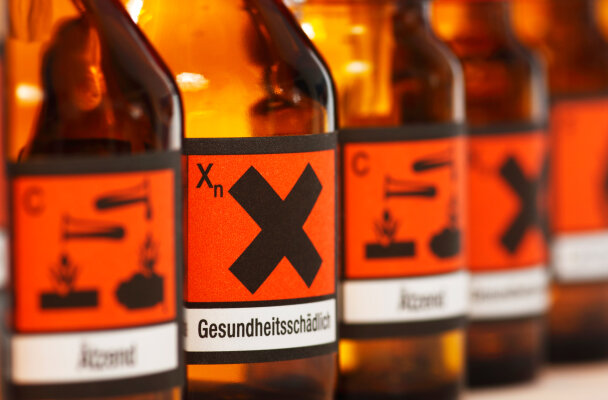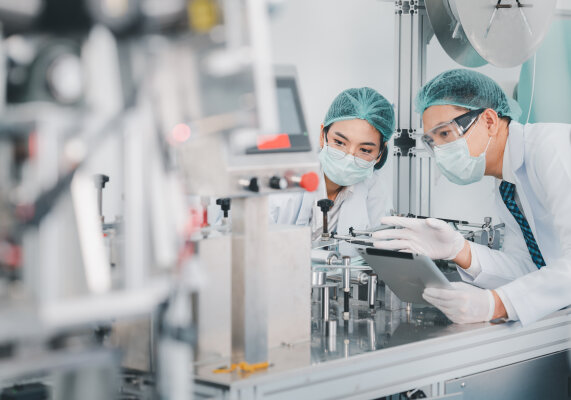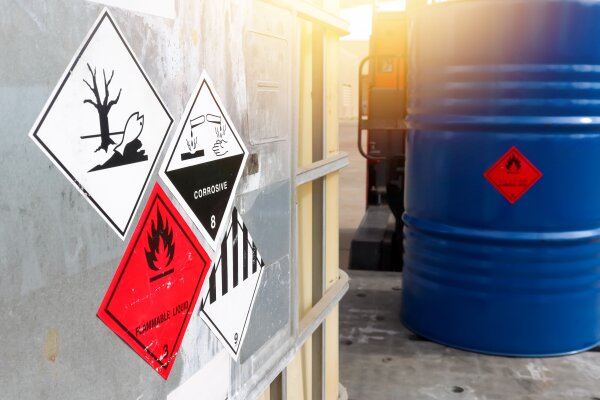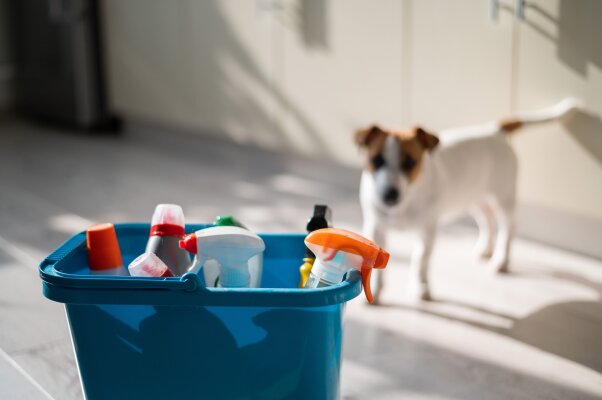UV air and surface disinfection for laboratories and research
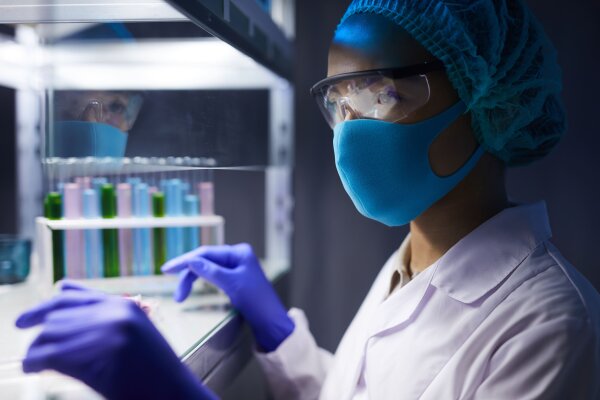
If contamination occurs in the laboratory, this can have serious consequences. Therefore, it is imperative to implement a process of air and surface disinfection. Zu diesem Zweck kann UV-Strahlung eingesetzt werden, die eine stark keimtötende Wirkung hat. Find out here which UV devices are suitable for this purpose and why you should choose corresponding products from the manufacturer Dinies Technologies GmbH.
How does the disinfection of air and surfaces work in the laboratory?
It is not only in recent years that the important role of sterilization mechanisms has come into focus. Various options can be considered for this, which differ from each other in terms of effectiveness, implementation and required technical equipment. Air and surface disinfection by means of UV radiation is a particularly good option. This avoids the use of chemical agents, so it protects health and the environment.
The basic principle of UV disinfection
Although there are different devices and technical implementations for UV disinfection, the basic principle always works the same in principle. For example, a short-wave, high-energy UV lamp is used, which emits a high proportion of UV-C radiation and brings about a targeted reduction in germs. In particular, the THEN of germs (think for example of viruses, bacteria or even mold) is irreversibly damaged.
This not only renders the pathogens harmless, but also prevents them from spreading further. The inactivation rates of UV light are extremely still and can more than keep up with chemical disinfections. With sufficient and extensive application, the inactivation rate is 99.99 %. This applies – depending on the device and implementation – not only for surfaces, but also for circulating air. At the same time, the indoor air quality is improved.
About the possible areas of application
The need for targeted and effective UV disinfection of surfaces and circulating air is necessary – and often indispensable – in many different places. These include not only industrial areas, but also research facilities, laboratories and areas of public life. The following application areas can be cited as good examples:
- Food industry: packaging (such as lids, films and containers), drinking water, surface of food, open food processing.
- Laboratories and research facilities: Protective equipment, samples, medical practices, waiting areas, hospitals.
- Production: surfaces of produced goods, packaging materials- tools, work surfaces.
- Public areas: Offices and meeting rooms, local and long-distance public transport, schools, educational institutions, retirement homes, restaurants, hotels.
UV disinfection devices should have these functions
In order for surface disinfection or air disinfection to function optimally in the laboratory and the like, several aspects should be considered when selecting a suitable disinfection device. This primarily includes performance. Thus, the generation of UV radiation must be adapted to the respective room size and/or the processed material. In most cases, for example, the manufacturer specifies how high the jet power is and how many square meters of room air can be covered.
Added to this is the radiation protection factor. Some “open” sterilizers are equipped with a special protective reflector so that people can be in the same room during operation. This is particularly useful when ongoing sterilization is required. In addition, look at the heat development – not all surfaces and materials can be processed with increased temperatures, after all.
Sterilizers – these different types are available
Not all sterilizers are the same – depending on the application areas and purposes to be covered, different types of devices come into question. For the most part, the following distinctions can be made in terms of structure and primary function:
- UV air purifier:UV disinfection of circulating air and improvement of indoor climate
- UV lamps: UV disinfection of air and surfaces (varies depending on the size of the lamps).
- UV chambers: UV disinfection of materials and objects (varies depending on the size of the irradiation chamber).
The Dinies UV chambers
Dinies Technologies GmbH is one of the leading companies when it comes to effective UV air and surface disinfection. The manufacturer’s high-quality UV chambers can be used for this purpose, which can be differentiated into the M series (M1, M2 and M3) and the ELG100s model.
Application and technical data
They can be combined with UV lamps in different wavelengths, so that flexible application areas are easily covered. The maximum operating temperatureis between 40°C (short start-up) and 50°C, which is why there is a suitability for temperature-sensitive materials – these can be brought close to the emitters, which increases the UV intensity on the surface and shortens the operating time.
The actual irradiation can also be controlled individually. For this purpose, the mechanical timer can be set to 4 hours or the electronic timer to up to 999 hours. The smooth-running drawer ensures safety when irradiating materials. In a direct technical comparison, the M series models and the ELG100s model differ from each other as follows:
| Technical data | ELG100s | M-Serie |
| Nominal power | 40 W | 100, 200 und 300 W |
| Dimensions | 175 x 83 x 306 mm | 225 to 425 x 155 x 255 to 464 |
| Weight | 3,4 kg | 4,0 bis 11,0 kg |
| Passage height | 14 mm | 45 mm |
| Timer | mechanical (0 to 4 h) | electronic (0 to 999 h) |
| Irradiation area | 225 x 150 mm | 220 to 429 x 195 to 395 mm |
| UV-A power (365nm) | 8 mW/cm² | 7 bis 8 mW/cm² |
| UV-B power (320 nm) | - | 6 mW/cm² |
| UV-C power (254 nm) | 15 mW/cm² | 220 to 429 x 195 to 395 mm |
| Operating hours counter | - | yes |
All important info about the ELG100s UV chamber
The ELG100s UV chamber from Dinies features not only a compact design, but also a light weight and compact construction. This UV chamber impresses with low temperature development and a shortened irradiation time with increased effectiveness, which ultimately also reduces operating costs.
The possible areas of application are diverse - they range from laboratory and research to food production and medical facilities. Especially for the sterilization of smaller objects, light polymerization and the erasure of EPROM's this UV chamber is ideal. As standard, this model is supplied with a UV-C lamp (253.7 nm), but can also be equipped with a UV-A lamp (365 nm).
All important info about the M series
This is contrasted by the M series from Dinies, which is divided into three models: M1, M2 and M3. These differ from each other in terms of dimensions and rated power, so that depending on the needs of more or less surface area and irradiation can be used:
- Dinies UV chamber M1: m100 W rated power with dimensions of 225 x 155 x 255, where 220 x 195 is irradiation area.
- Dinies UV chamber M2: 200 W rated power with dimensions of 425 x 155 x 255, where 220 x 395 is the irradiation area.
- Dinies UV chamber M3: 300 W rated power with dimensions of 425 x 155 x 464, where 429 x 395 is the irradiation area.
These UV chambers are both robustly built and can be combined with different lamp wavelengths, making environmentally friendly disinfection without chemicals quite simple. This ensures that they are safe in terms of health and the environment. They are slightly larger and more powerful than the ELG100s model, making them additionally ideal for aging and materials testing, surface and object disinfection, and curing of paints, coatings, resins, and adhesives.
The UV-C disinfection modules from Dinies
In order to be able to perform surface disinfection, Dinies has also developed UV-C disinfection modules. These can be differentiated into the NIX 30-1 and NIX 30-2 models. These compact UV lamps significantly reduce airborne microbial contamination by achieving up to 99.99% kill of microorganisms of many types. There is no chemical contamination whatsoever, which makes the devices environmentally friendly and harmless to health. There are many conceivable areas of application in air and surface disinfection:
- Air disinfection: laboratories, doctors' offices, hospitals, retirement homes and day care centers; food industry (processing, selling, storing); high-traffic buildings; public transportation.
- Surface disinfection: tools and other equipment; food (such as fruits and vegetables) and packaging; work surfaces of all kinds.
Air sterilization also improves the indoor climate, which happens with the help of natural air circulation - there is no noise, which protects nerves and ears. In direct technical comparison, the following similarities and differences between the two UV lamps can be pointed out:
| Technical data | NIX 30-1 | NIX 30-2 |
| Nominal power | 35 W | 65 W |
| Dimensions | 970 x 90 x 40 mm | 1140 x 135 x 160 mm |
| Weight | 1,6 kg | 3 kg |
| Rated voltage | 230 V, 50/60 Hz | 230 V, 50/60 Hz |
| Luminaire output | 1x 30 W | 2x 30 W |
| Integrated protective reflector | - | yes |
| UV-C power (254 nm) | 10 W | 20 W |
| Air disinfection | yes | yes |
| Surface disinfection | yes | yes |
| Irradiation power (1 m distance) | 0,21 mW/cm² | 0,42 mW/cm² |
| Irradiation power (5 m distance) | 58,8 mW/cm² | 116 mW/cm² |
The NIX 30-1 disinfection module
The NIX 30-1 disinfection module is a UV lamp equipped with a single 30 W UV-C lamp. This results in a more compact design that can also fit into small spaces. Since a protective reflector is provided, the model may only be operated when there are no persons or animals in the room.
The UV light allows to effectively sterilize from mold as well as bacteria and viruses. The recommended room size for this unit is 25 m2 (over 8 hours) for mold and 16 m2 (over 2 hours), 64 m2 (over 4 hours) and 144 m2 (over 8 hours) for bacteria and viruses.
The NIX 30-2 disinfection module
Things get even more powerful with the Dinies NIX 30-2 disinfection model, which comes standard with two 30 W UV-C lamps. This results in more length and greater beam power, so that up to twice as much area can also be covered. In addition, this model has an integrated protective reflector- so it can be operated even if there are people in the room.
The double tube construction provides a robust structure suitable for use in cold rooms. Surfaces in the upper air space can also be irradiated, so that the possible areas of application are extended. The recommended room size is listed as 50 m2 (over 8 hours) for mold and 32 m2 (over 2 hours), 128 m2 (over 4 hours), and 288 m2 (over 8 hours) for bacteria and viruses.
Dinies Technologies GmbH - high quality UV disinfection from Germany
The manufacturer Dinies Technologies GmbH was founded in 1979 in Villingendorf near Rottweil and produces modern solutions for UV disinfection "Made in Germany". Special attention is paid to the concept that everything comes from a single source - from mechanics to electronics. In the meantime, the company focuses on the standbys of electronics and UV technology, which are promoted by an innovative company policy.
Dinies UV disinfection equipment at MedSolut - We will be happy to advise you
Do you need more information about the products or do you have any questions? Then our experienced team of expert consultantswill be very happy to help you! We can also help you put together a suitable UV disinfection system for your requirements. Simply contact us by email at info@medsolut.com or all day by phone at +49 30 2096579 00.

